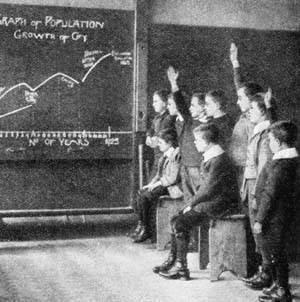During the last eighteen months, the public have been bombarded with stories of asteroids, near misses and the danger of celestial impacts. Space around the Earth is littered with small lumps of rocks, only dimly perceived by scientists until recently. Although each asteroid is smaller than a city, it would be capable of wreaking havoc, on an unimaginable scale, should it collide with our planet. At the same time, geologists are beginning to warn us about the dangers of extraordinarily large volcanic events that periodically shake the planet. They have also found evidence for large coastal landslides that created enormous tsunami (the preferred scientific term for the misnamed tidal waves). Earth, it seems, is no cradle to humanity. It is more of a testing ground; a harsh, dispassionate realm in which species are subjected to the severest rigours of natural selection.
Scientists began to believe in catastrophes in the 1980s when Luis Alvarez and his colleagues presented geological evidence to show that the extinction of the dinosaurs was caused by the impact of an asteroid. One of the defining moments of this realisation took place on July 16th 1994. For perhaps the first time in history, human beings witnessed the impact of one celestial body with another. It was a titanic event. The comet, Shoemaker-Levy 9, had been captured by the gravitational field of Jupiter and broken into over twenty large fragments. Some of them are thought to have been as big as the one that ended the reign of the dinosaurs.
In his book, Impact!, Gerrit L. Veschuur recounts how he heard a news report in which the interviewer asked an astronomer what this event meant to the man in the street. The astronomer replied to the effect that he should be grateful he was not on Jupiter.
Scientists had once before believed in the doctrine of catastrophism. However, it was mired with the religious belief that there had been a catastrophic flood. During the first decades of the nineteenth century, the Reverend William Buckland of Oxford University, thought that the new science of geology (or undergroundology as he preferred to call it) could be used to gather evidence in support of the Bible. In particular, it should be able to prove the flood of Noah.
At the time, the first dinosaur fossils were being dug out of quarries around England. The finds were tantalising because they represented species that had once lived on Earth but no longer did. In fact, their disappearance from the rocky strata was so abrupt that it signalled a cataclysm. In Paris, Baron George Cuvier had already made his reputation by studying fossil "elephants" that he showed were an entirely different species, the mammoths. These too had become extinct, but more recently than the dinosaurs.
Eventually Cuvier developed his "Doctrine of Catastrophes" in which he postulated that the ancient Earth was subjected to a series of floods, each one causing species to be lost. Religious leaders seized the work as positive proof that the telling of Noah's flood was substantially correct. William Buckland also embraced the idea as encouraging, although he still clung to the notion of a single flood. Others were not convinced. A former undergraduate of Buckland's, Charles Lyell, set about explaining the formation of geological features. In the process, he undermined the Doctrine of Catastrophes so successfully that it would lie in ruins for a century and a half.
According to Buckland, all of Earth's valleys were created during the biblical flood. This explained why there was little correlation between the size of a valley and the size of the river that flowed through it. Lyell, on the other hand, used geological finds to theorise that different erosion rates, over immense periods, were responsible.
This gradual change of the landscape could account for animal extinctions, too. In a direct challenge to Cuvier's authority, Lyell proposed that, as the environment changed gradually, animals became unable to survive in the new conditions and died out. No cataclysms, just a gradual, background rate of extinctions with time.
Despite incontrovertible and growing evidence that there were distinct eras of different creatures, the scientific community embraced the idea of gradualism. Perhaps this was because the only global catastrophe postulated was the religious one of deluge. Certainly, by denying that catastrophe played a role in extinction, the scientists stopped the Church from inveigling their ideas, as it had with Cuvier's theory.
Darwin also incorporated gradualism into his Origin of Species in 1859. Central to his thesis were that natural selection dictated evolutionary change and the environment dictated natural selection. Since environmental change was gradual, evolution could not help but be gradualistic also.
The first rumblings of discontent with gradualism, that were taken seriously, began in the 1970s. By then, scientists such as Stephen Jay Gould had performed extensive analysis of the fossil record and showed that periods of evolutionary stasis were punctuated by rapid change. The concept was called punctuated equilibrium and logically pointed to sudden environmental change.
The idea paved the way for the widespread acceptance of Alvarez's theory about the demise of the dinosaurs and heralded a return to the ideas of catastrophism. Suitably updated and placed on a firmer footing, the doctrine of neocatastrophism has taken hold.
Now, scientists have a number of different catastrophes to choose from. As well as asteroid and comet impacts from space, there are also colossal volcanic eruptions and tsunami to contend with. Some scientists also warn that the Yellowstone National Park is a volcanic timebomb, waiting to blow. It lies over a "hot spot" that has erupted catastrophically three times in the past. Each eruption has been separated by about 600,000 years. The bad news is that it has been 630,000 years since its last eruption.
Rather like astronomers talking about asteroid strikes, whenever geologists are interviewed about these events, they are at pains to emphasize their descriptions are a matter of "when", not 'if'.

